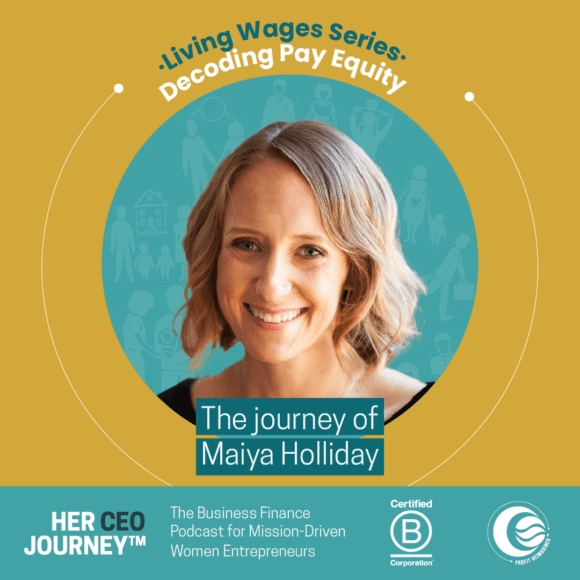What Our Web Agency Has Learned About Pay Equity
What it is, why it’s a tough topic, and why it’s worth the work

 Update: Check out our founder Maiya Holliday on the Profit Reimagined podcast discussing Pay Equity
Update: Check out our founder Maiya Holliday on the Profit Reimagined podcast discussing Pay Equity
As a B Corp, we are required to report whether each team member’s pay is above the “livable wage” for their respective location. While our compensation has always far exceeded these meager minimum wage levels, this exercise sparked a deeper curiosity into how to achieve actual pay equity, and whether or not a location-based wage comparison is a fair benchmark for determining equitable compensation for our global team. If not, is there a different model that would more accurately reflect our collective values and needs?
One thing that has become very clear is that establishing pay equity for a remote, global workforce is challenging and imperfect. We are still a ways from landing on a formula or model that feels truly comprehensive for us, but we are gaining traction. We have been actively researching various models and talking internally with our team about what resonates with them. Our ultimate goal is for everyone to be compensated fairly for their work and feel that their wages reflect their value to the company, while working within a model that is financially sustainable. Here are some of the things we’ve learned about this complex concept, why it’s challenging, and why it matters.
What Is Pay Equity?
Pay equity, in its most basic form, refers to equally compensating employees who do similar work, regardless of their demographic. An equitable compensation model supports diversity, helps reduce unconscious bias, dispels social injustice, and supports employees in feeling valued and empowered at work. A clear example of pay inequity is the U.S. gender pay gap. According to the US Bureau of Labor Statistics, white women in the United States earn, on average, 83 cents for every $1 earned by white men. Not shockingly, the gender pay gap is larger for women of color, with Black and Latina women holding Bachelor’s degrees earning 65 cents for every $1 earned by their white male counterparts at the same educational level.
Data like this is relatively quantifiable. But what if you want to consider other factors to calculate compensation, such as remote versus in-office, cost of living in various locations, or benefits that are adjusted for having dependents or not? It’s in these questions that the waters get muddy.
There’s No Single Source of Truth
It’s difficult to find any tried-and-true method for determining equitable pay, as there are various factors that every business might prioritize differently. A big question for us as a global remote agency has been: How much should we factor an employee’s location and cost of living into this formula? Is it more equitable to pay everyone the same, no matter where they live, even though it would mean that people in high-cost-of-living areas would have less relative income than those in low-cost-of-living areas? What factors should be considered beyond location? For example, it’s not uncommon to consider dependents when determining benefit packages (ie covering family vs individual insurance premiums or providing childcare offsets) – should we consider supporting caregivers differently as a factor in our calculations? If so, is that fair to those who don’t have or don’t plan to have children?
We found a few helpful examples of companies implementing well-documented pay equity policies for their remote workforces to reference in the face of all of these unknowns.
GitLab, a fully remote organization with employees in over 65 countries, has built a calculator that determines equitable and competitive pay based on local rates. As they describe it, their formulaic approach was developed to be transparent, efficient, and fair across teams, levels, and countries. The calculator benchmarks against a San Francisco-based salary for the role in question, then factors in local labor costs, experience level, and exchange rate against the USD.
Buffer, another fully remote organization, takes a slightly different approach to location-based remote compensation. They also start by setting compensation against comparable industry salaries in San Francisco, and then make an adjustment for varying living costs by using one of two broad multipliers—one for “high-cost-of-living” areas and one for “average-cost-of-living areas”.
Both GitLab and Buffer publicly acknowledge that their pay models might not be perfect and leave space for alterations and improvements. The level of transparency and thoughtful documentation for each of these models is noteworthy.
1. Cost of Living Indexes Vary Greatly
Even if you have determined how you want to factor location into your pay calculations, one significant challenge here is obtaining accurate data. There are a myriad of free tools to calculate living costs by location, but the numbers vary wildly. At the time of writing this article, we used two free tools to calculate the cost of living (without rent) for a single person living in Salt Lake City, Utah, as an example. Here are the results:
Numbeo: $909.66
Livingcost.org: $694
We have also heard anecdotally that many of these indexes are far too inaccurate for one’s actual experience in each of these cities.
There are some paid tools out there, too, that may pull from more robust and dynamic data sources, but these tools can be prohibitively expensive for smaller organizations. Since we have team members spread around the world, we’ve always tapped into cost of living indexes to help inform our decisions about fair pay, but we only reference these numbers in conjunction with other factors. When we do consider cost of living indexes, we reference multiple data points, take the average, then take note of any major outliers we find. In a sense, we are learning toward using Buffer’s approach of wider cost of living multipliers vs relying on granular city or country-specific data that we don’t feel is accurate enough. Obviously wider cost of living multipliers are not 100% accurate either, but they seem to be more reasonable to follow than city-specific data that’s questionable and overly cumbersome to track.
2. It’s a Balancing Act
One of the most basic and important aspects of developing any pay model is that everyone gets paid consistently and has stability in their position. We try to be transparent about our thinking, including the fact that it’s important to us for team members to feel valued and to see that reflected in their compensation, and it’s equally important to maintain a financially sustainable business in the process. Thus, we always aim to set rates generously but practically – we would much rather pay out bonuses at the end of the year than face payroll stressors because we didn’t leave a large enough margin for error when planning a pay model.
3. Dialogue Is Necessary
We’ve chosen to work collaboratively with our team versus allowing leadership to make these decisions for everyone, a core part of our efforts to dismantle the white supremacy characteristic of paternalism within our organization. So, we polled the agency to hear everyone’s voices on what they’d like to see in a compensation structure, including how much location and other factors discussed here should play a role in compensation levels. We’re taking in this feedback as we continue refining our approach. Having open conversations about pay has also allowed us to consider other ways to financially support our employees, including:
- Monthly check-ins to ensure team members have enough hours, and to discuss any special circumstances that might lead to reexamining compensation or weekly commitment (many of our team members work hourly or have variances in their time commitments)
- Yearly pay reviews and ongoing inflation adjustments
- EOY bonuses to all team members, based each member’s performance and participation during that year
- Zero-interest pay advance program for all established team members
Conclusion:
While a standardized pay equity model is still a work in progress at Mangrove, we hope that our findings and considerations so far are helpful for other organizations who are trying to find a fair compensation framework, too. Our eventual solution may not look exactly like yours, but it’s our hope that if we create dialogue and share ideas around this complex topic, we can raise the bar much higher than simply considering a “living wage.” Don’t hesitate to reach out to us with any questions, ideas, or comments you might have about pay equity at Mangrove or within your organization.
A Certified B Corp, Mangrove is a woman-owned website design and development company with a diverse, talented team distributed around the globe. We’ve been building websites since 2009 that amplify the work of change-making organizations and increase the competitive power of businesses owned by historically marginalized people.
If you found this post helpful, subscribe to our monthly newsletter for notice of future posts and other news from us.




